Larynx part II: Mucosa and Muscles
So far we have seen the structure of the "skeleton" of the larynx, its one bone and several cartilages. Now we must try to understand how those move with reference to one another, via the muscles. But before we do that let's look at the Muscosa, the tissue that covers the muscles of the larynx.
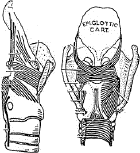
Intrinsic Muscles of the Larynx
This simplified image will
help you visualize the placement of each of the muscles described in the table
at right. Please note that some of the muscles are labeled using the older
more "latinate" terms for them.
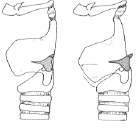
Cricothyroid Joint
The action of the cricothyroid
tilts the tyroid cartilage down, increasing the front to back distance of
the larynx, and thus placing the vocal folds under increased tension.
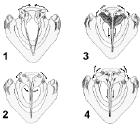
Movement of the arytenoid cartilages
These four views show how
the vocal folds are approximated by the action of the intrinsic muscles on
the arytenoid cartilages.
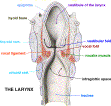 This image is a good starting
point for any discussion of the muscles and mucosa because one can see the
placent of the vocalis muscle (in the vocal fold) and the various layers that
cover it. [Take a look at it (another window will pop up, so you won't loose
your place), and then come back to continue.] Notice how narrow the opening
is between the vocal folds, compared to the width of the trachea: this space
is called the "glottis".
This image is a good starting
point for any discussion of the muscles and mucosa because one can see the
placent of the vocalis muscle (in the vocal fold) and the various layers that
cover it. [Take a look at it (another window will pop up, so you won't loose
your place), and then come back to continue.] Notice how narrow the opening
is between the vocal folds, compared to the width of the trachea: this space
is called the "glottis".
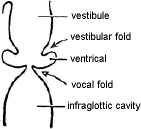 Let's
now look at an image of the other spaces created by the various structures
of the larynx. In the image at left, we see the vestibule, which is
the space above the "vestibular fold". These "false vocal folds"
are created by the mucosa passing over the vestibular ligament. They vibrate
somewhat during phonation and especially during vibrato singing. The false
vocal folds also work with the epiglottis to make a seal so that nothing goes
down the windpipe during swallowing. Tucked below the vestibular fold is the
ventricle. The space below the glottis is the infraglottic cavity.
Let's
now look at an image of the other spaces created by the various structures
of the larynx. In the image at left, we see the vestibule, which is
the space above the "vestibular fold". These "false vocal folds"
are created by the mucosa passing over the vestibular ligament. They vibrate
somewhat during phonation and especially during vibrato singing. The false
vocal folds also work with the epiglottis to make a seal so that nothing goes
down the windpipe during swallowing. Tucked below the vestibular fold is the
ventricle. The space below the glottis is the infraglottic cavity.
Mucosa
The soft tissues of the larynx, particularly the vocal folds.

The "true" vocal folds - are made up of five layers:
- epithelium - the surface "skin" of the the larynx, which is continuous with the lining of the mouth, pharynx and with the trachea below the larynx.
- lamina propria - three distinct layers, each
with a different consistency
- superficial layer: a jelly-like substance, close to the surface
- intermediate layer: an elastic, fibrous substance, like rubber bands
- deep layer: a thread-like collagenous fiber layer
- vocalis muscle: the main body of the vocal fold, and very stiff
This image (in black and white) shows the nature of the tissue a little more clearly.
The epithelium and superficial layer of the lamina propria are often considered the cover of the fold, the intermediate and deep layers of the lamina propria are thought to be a transition while the vocalis muscle is the body of the vocal fold. The soft, gel-like composition of the cover is important for creating the "mucosal wave", barely visible in this animated gif image.
Intrinsic Muscles
These smaller muscles, within the structure of the larynx, move the vocal
folds in reference to each other: they abduct, adduct and alter vocal fold
shape; they also change the longitudinal tension.
[abduct = move apart, adduct = bring together. How to remember this? aDDuct:
the 2 D's go together, aB-Duct: the B and D are separated]
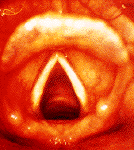 This
image (not expandable) shows the vocal folds abducted (yes, separated!), for
inhalation. You can see the two bumps of the of the arytenoid cartilages near
the bottom corners of the picture, the vocal folds are making a V pointing
at the thyroid cartilage, and you can see the shiny epiglottis at the top
of the image, like a crescent moon. Looking inside the glottis, you can make
out the rings of the trachea.
This
image (not expandable) shows the vocal folds abducted (yes, separated!), for
inhalation. You can see the two bumps of the of the arytenoid cartilages near
the bottom corners of the picture, the vocal folds are making a V pointing
at the thyroid cartilage, and you can see the shiny epiglottis at the top
of the image, like a crescent moon. Looking inside the glottis, you can make
out the rings of the trachea.
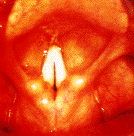 In this image (not expandable), the vocal folds are adducted for phonation
on the exhaled breath. You can see that the arytenoid cartilages have swung
forwards and together to bring the edges of the folds into contact. The folds
are photographed in mid vibration; you can see the degree to which the folds
separate during each vibratory cycle (not much!). The folds appear white in
colour because there is very little blood flow to the fold tissue, and the
arteries are microscopic. However, if a blood vessel were to break, the results
would be very dramatic, as the tissue would quickly fill with blood, turning
a deep red colour.
In this image (not expandable), the vocal folds are adducted for phonation
on the exhaled breath. You can see that the arytenoid cartilages have swung
forwards and together to bring the edges of the folds into contact. The folds
are photographed in mid vibration; you can see the degree to which the folds
separate during each vibratory cycle (not much!). The folds appear white in
colour because there is very little blood flow to the fold tissue, and the
arteries are microscopic. However, if a blood vessel were to break, the results
would be very dramatic, as the tissue would quickly fill with blood, turning
a deep red colour.
To figure out where each of the muscles named below goes, remember that their names are made up of the two cartilages that the muscles join. For instance, the cricoarytenoid muscle moves the cricoid cartilage and the arytenoid cartilage.
| Intrinsic Muscle Name | Comments | |
| thyroarytenoid | or vocalis muscle | |
| posterior cricoarytenoid | ||
| lateral cricoarytenoid | ||
| arytenoid (oblique & transverse) |
move the arytenoids with reference to one another | |
| cricothyroid | (check out this image) |
Extrinsic Muscles
These larger muscles, outside the larynx, position and support the larynx;
they may move the cartilages, which in turn, stretch or compress the vocal
folds.
| Extrinsic Muscle Name | Joining these structures | |
| sternothyroid | (sternum, thyroid cartilage) | |
| thyrohyoid | (thyroid cartilage, hyoid bone) | |
| inferior pharyngeal constrictor |
(bottom of the "throat", the pharynx) |
Laryngeal Elevators
These supplemental muscles raise the larynx in the neck or support it. AKA
Suprahyoid muscles. Some of these muscles are visible in this
image of the tongue, as they are also extrinsic muscles of the tongue.
| Elevator Muscle Name | Joining these structures | ||
| stylohyoid | (hyoid bone, styloid process) | ||
| mylohyoid | (both sides of the jaw [forming the floor of the mouth], hyoid bone) | ||
| geniohyoid |
Onto Physiology - how it works
Back to part one, Overview and the Cartilages
Back to Phonation
More on the Larynx
View the Vocal Folds in action
This is a rather shakey view of the vocal folds in action - a gif animation.
Catch the Wave:
View the Vocal Folds in action, part 2. This is another shakey view of the
vocal folds in action - a gif animation, this time based on line drawings
of the folds seen in cross section.
Centre
for Voice Disorders
Wake Forest University's excellent Centre for Voice Disorders has all the
information you need to know about what can go wrong with vocal folds. Lots
of images, and very specific information on medical conditions.



